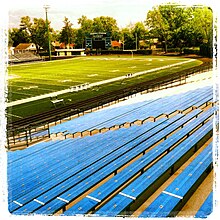This article has multiple issues. Please help improve it or discuss these issues on the talk page. (Learn how and when to remove these messages)
|
Field of Dreams | |
 Overhead shot of the stadium | |
 | |
| Location | 301 Baldwin Ave. Findlay, Ohio 445840 |
|---|---|
| Coordinates | 41°02′59″N 83°45′21″W / 41.04972°N 83.75583°W |
| Owner | Findlay City School District |
| Operator | Findlay High School |
| Capacity | 5000 (1928–1966) 6700 (1966–1970) 7150 (1971–1989) 8200 (1992–present) |
| Surface | Field Turf 2007–present Kentucky Bluegrass 1992–2006 Cynodon dactylon 1928–1991 |
| Construction | |
| Broke ground | 1927 |
| Opened | October 27, 1928 |
| Renovated | 1929, 1930 1979, 1999, 2007, 2012 |
| Construction cost | $150,000 USD ($2.63 million in 2023 dollars[1]) |
| Tenants | |
| Findlay High School (OHSAA) (1928-present) University of Findlay (NAIA) 1940-1998 (NCAA) (1998-present) | |
Donnell Stadium, which was built in 1927 at a cost of $150,000, continues to serve as one of the stadiums of Ohio.
A gift for Findlay City School District from Otto D. Donnell, Donnell Stadium was the original dream of J.C. Donnell, president of the Ohio Oil Company. His presentation of the site where Donnell Middle School now stands was the first step in his dream.
On October 27, 1928, Donnell Stadium was dedicated and the deed to the stadium handed over to the Findlay Board of Education.

Over 80 years ago, James C. Donnell's dream of providing a place in Findlay where ‘games of youth’ could be conducted was realized by the citizens of Findlay. Donnell, son of James C. Donnell, and then president of The Ohio Oil Company, the forerunner of today's Marathon Oil Company stood before a crowd of over 2,000 people and said, “We have endeavored to the best of our ability to carry out the plans in accordance with the wishes of the originator of this idea, and our only regret is that he was not spared to be present at the dedication and to share the happiness of this occasion.” Donnell's, untimely death in 1927, one year prior to the completion and dedication, prevented him from being a part of these ceremonies. Years earlier, however, Donnell resolved to give the public schools in Findlay an athletic field. His gift of the site where Donnell Middle School currently sits was his first step toward his goal. Donnell's son, Otto and grandsons James C. (II), John R., and Otto D. (Jr.), carried his goal to completion after his death.
A graduate of Case Institute of Technology (now part of Case Western Reserve University), O.D. Donnell called on former classmates to serve as architects for the stadium project and drive it through execution. It attracted attention statewide, partly because of its unique physical structure for the times. And the fact it was constructed and given to the Findlay City Schools at no cost was quite unusual in that era. Findlay embarked in 1928 on a growing athletic program with no expense to the taxpayer, an envy of many communities throughout the state of Ohio. O.D. Donnell continued his guidance and financial support for improvements to the stadium from 1928 to 1936, donating tennis courts to the schools in 1928, followed by the combination wading pool and skating rink in 1930. The largest electronic scoreboard in Ohio was also installed in 1930, along with a public address system. Lights were added and the first night game was played in 1930 with the Trojans defeating Bowling Green, 13–0.
In 1936 O.D. Donnell established the “Donnell Foundation” to provide ongoing financial support for maintenance and improvements to the stadium and adjacent recreational areas.
Donnell Stadium is still operational where it continues to host football games and other events. Currently, the venue holds numerous attendance records at OHSAA sponsored playoff games.
- ^ 1634–1699: McCusker, J. J. (1997). How Much Is That in Real Money? A Historical Price Index for Use as a Deflator of Money Values in the Economy of the United States: Addenda et Corrigenda (PDF). American Antiquarian Society. 1700–1799: McCusker, J. J. (1992). How Much Is That in Real Money? A Historical Price Index for Use as a Deflator of Money Values in the Economy of the United States (PDF). American Antiquarian Society. 1800–present: Federal Reserve Bank of Minneapolis. "Consumer Price Index (estimate) 1800–". Retrieved February 29, 2024.